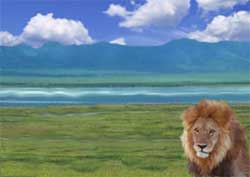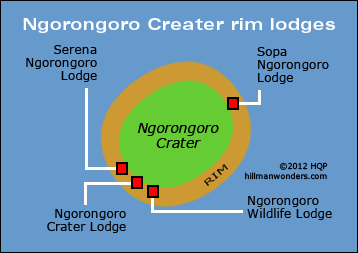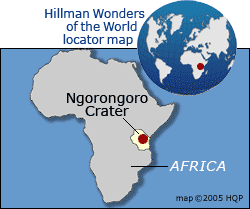Ngorongoro Crater
 Why the
Ngorongoro Crater
is special
Why the
Ngorongoro Crater
is specialIt is a haven for tens of thousands of big East African wild animals in north central Tanzania.
How the Ngorongoro differs from the Serengeti and Masai Mara
Migration
Compared with the Serengeti and Masai Mara, the migration in the Ngorongoro Crater is scant. Reasons: It has an abundant year-round food and water supply - and the precipitous walls of this collapsed extinct volcano discourage (but don't totally eliminate) migrating.
Human contact
I noticed that the wild animals within the Ngorongoro Crater are less people shy to safari vehicles than those in the Serengeti.
This makes it easier to view the animals up close. That helps explain why some seasoned safari goers believe that the Ngorongoro Crater is the most interesting wildlife preserve in the world.
 Why the
Ngrongoro Crater safari
animals are special
Why the
Ngrongoro Crater safari
animals are specialMany animals
The Ngorongoro Crater has an unrivaled high density of big safari animals including lions, elephants, hippos, cape buffaloes, zebras, wildebeests, and the endangered black rhinos. It has a year-round population of approximately 30,000 large safari animals.
Where are the giraffes?
You won't see any for two reasons. First, the giraffe has long, spindly legs, which makes it difficult for it to climb into and out of the steep-walled Ngorongoro Crater (see photo). Second, nature designed the giraffe's long neck for nibbling on the leaves of tall trees, its chief food. Although such trees exist in sufficient number in the other major game reserves, they are rare here.
Always there
One of the Ngorongoro Crater's major appeals is that the animals will likely be there en masse when you are. There are no seasonal shrinkage of the game population (except during droughts). Reason: There is little need for animals to migrate. The crater's lakes, ponds and streams supply ample water - and the grasslands provide sufficient year-round food for grazers. In turn, this creates food for lions and other predators.
Great sightings
Another tourist appeal is the openness of its vast grasslands - this increases your game viewing.
About the crater
Immense
The crater is 20 kilometers (12 miles) in diameter. Its ring-shaped wall is as high as a 200 story building and hems in the 260 square kilometer (105 square mile) flat crater floor where a year-round population of approximately 30,000 large safari animals roam.
If you built stadium seats on the crater's sloping wall, you could comfortably sit over 30 million spectators.
Bring a sweater or jacket
The rim is about 2,300 meters (7,500 feet) above sea level, so expect chilly evenings and mornings even though you are near the equator.
Not a real crater
Technically, the Ngorongoro Crater is a caldera, not a true crater because its circular wall is the remnant of collapsed sides of a dormant or extinct volcano. Its peak once rose 8000 kilometers (26,000 feet) above sea level.
About the Ngorongoro Conservation Area (NCA)
Geography
The Ngorongoro Crater is part of the vast NCA. It is only a tiny fraction of that land mass.
Lodging
Just four lodges
The number of lodges at the Ngorongoro crater is limited, but all of them are situated on or very near the rim. This gives guests breathtaking views of one of the outstanding natural wonders of the world. It stretches out to the horizon before their very eyes.
Rates
$$$$ = high, $$$ = mid-to-high
Best lodge: Ngorongoro Crater Lodge - $$$$
The private decks of the 30 stylishly appointed guest suites have stunning views of the Ngorongoro Crater floor (see photo). High staff-to-guest ratio delivers superb service. Guests enjoy exclusivity and privacy.
The other three lodges of the Ngorongoro Crater
- Sopa Lodge - $$$
92 guest suites are in semi-detached structures. All have wide, floor-to-ceiling windows overlooking the vast Ngorongoro Crater.
- Ngorongoro Serena Lodge - $$$
Many of its 75 guest rooms have private rock-walled terraces offering crater views (ask for one).
- Ngorongoro Wildlife Lodge - $$$
Good views, but the interior decoration of the 75 guests rooms is rather lackluster.
Options
There is a luxury camp (Lemala) on the rim. However, you don't get the sensational views of the crater from your room or main unit as you do from the lodges
The more basic campsites are not near the rim. Moreover, you simply cannot walk to the rim on your own for the view. The reserve makes that illegal for safety's sake (wild animals roam the rims and the crater's walls are hazardously sheer and deep). Your explorations require an accredited guide.
Location




